
You’ve all been driving along, minding your own business, and then a weird sound starts coming from under your hood. So, you take your car into the shop and the mechanic usually says the same thing: “let’s take a look.” They’re basically about to do the deep dive because it’s not enough for them to know that there is a problem. Instead, they need to understand the nature of that problem to find a meaningful solution. Business problem solving is the same way. As long as you can get specific about what went wrong, you’re already setting up a future where things go right. This article teaches you how to troubleshoot business challenges, because as Marcus Lemonis has said, “Things are going to go wrong… it’s how you resolve it that matters the most.”
10 Steps to Effective Business Problem Solving
1. Define the Problem
Marcus always tries to get to the root of the issue, which is exactly what he did when he worked with a Wisconsin-based safety company that manufactures non-slip products for people and animals. They mentioned needing more capital so they could expand, but before Marcus broke out the checkbook, he wanted a deeper understanding of the company’s challenges. He learned that they were operating under two names, which created confusion in the marketplace. Their packaging could’ve been more clear. Their slip-and-fall line of products needed a tune-up as well. Marcus’ closer look was really beneficial because it gave them an opportunity to tighten things up and make the most of their expansion. Make sure you do the same. Take a comprehensive look at everything including your competition, your business model, the marketplace, your team, and your own goals. Because in every discovery is an opportunity to improve.
2. Conduct a S.W.O.T. Analysis
This exercise is a great way to take a hard look at yourself as a company. First, it asks you to list your company’s internal Strengths and Weakness. For example, your strength might be your ground-breaking product, and your weakness, that 5% margin. Next, you document all of your external Opportunities and Threats. An opportunity might be a government contract that’s recently up for grabs, while a threat could be that hard-charging competitor.

This exploration is a great way for small businesses to grow more self-aware, but even large companies do a version of this. Coca-Cola identified that one obvious threat to their company was the pandemic, but they responded in a brilliant way. They saw an opportunity to beef up their no-contact points of distribution. They knew that people wanted to make fewer trips to the store, so they ramped up the supply of bulk products. They even identified and cut “zombie products,” which were just sort of chugging along and underperforming. Think about using a SWOT Analysis as a strategic planning tool, because as long as you know the problem, there’s always a solution around the corner.
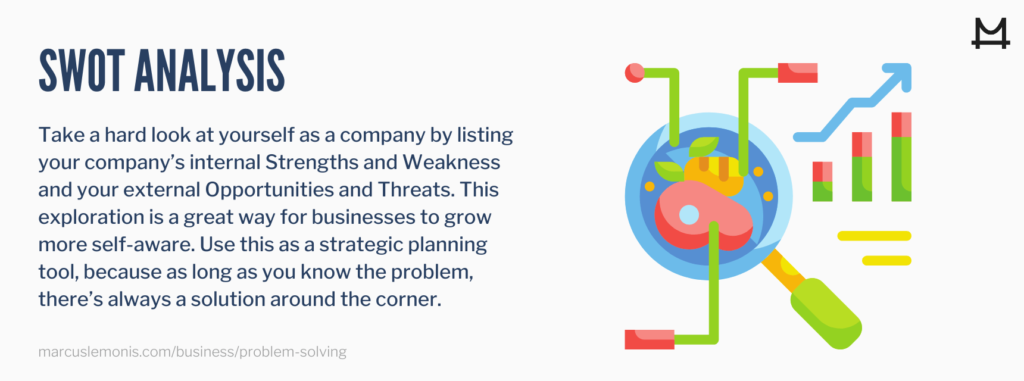
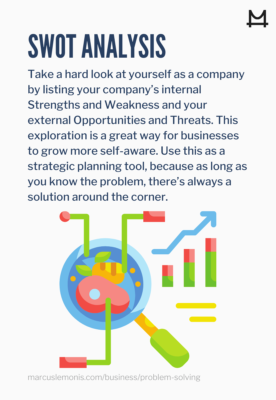
3. Conduct Market Research
It’s always important to take emotion out of your self-assessment and one way to do that is by gathering and analyzing data. When’s the last time you’ve sent out a customer survey? Companies like Survey Monkey allow you to proactively solicit feedback. This helps you gain a better understanding of your customers’ pain points, their awareness of your current products, their buying habits, and demographics.
You’ll also want to gain a deep understanding of the competitive landscape. Have you ever built a competitive matrix? It’s basically a loose SWOT Analysis of everyone in your field. Knowing where everyone stands, including the people you’re up against, helps reveal the most promising path ahead. Really try to quantify as much as you can. From there, be open to the truth. Because as Marcus would say, “The numbers don’t lie.”
4. Get Input from Your Team
You’re great with the big-picture, but keep in mind, your “boots on the ground” are an incredible resource for understanding the nitty-gritty. You see that when Marcus visited a high-end clothing company in Michigan.

Their high-quality pants were completely hand-crafted. That meant an intricate process went into making every single pair. Marcus worried the process for making jeans was taking too long and wondered if there was a way to keep their level of quality while speeding things up. He sought input from the employee who actually made the jeans, and as it turned out, she found a much more efficient way to crank out the same level of quality with significantly fewer steps in the process. How can you lean on your team to help you with business problem solving? Be sure to ask them a few questions and their answers might surprise you.
5. Identify Multiple Solutions
There’s an old brainstorming trick in creative fields that invites you to throw away your first ten ideas. That’s a little extreme, but what it’s really doing is encouraging you to push yourself. Maybe a competitor already tried your first idea. Maybe your second idea is a little too expensive. Maybe your third and fourth idea are both really exciting and you want to try them both. The point is that business problem solving can be a numbers game. There’s a reason that a country’s population size often correlates to success in the Olympics. They have more competitors to choose from, which means more chances at excellence. So, make sure your business explores every opportunity, and not only will you end up with better solutions, but you might find an opportunity to completely reinvent yourselves.
6. Model Different Financial Scenarios
Once you put some great ideas out into the room, you’ll need to give a little thought to their execution. Remember Marcus’ classic “Know your numbers” philosophy? Make sure you know how much time each solution takes. Would you need to hire anyone new? Would you need to buy any new equipment? Are there any additional marketing costs? How much would implementation affect your current output? How much would that loss in output set you back financially? Knowing these numbers allows you to think in terms of cost / benefit, because the last thing you need is a $1 million solution for a $100 problem. So, then take a look at the upside. How much are you improving margins? How much are you increasing your output? What is the net financial benefit of the solution over time? Does the math work? This sort of financial planning will allow you to solve your problem without creating another.

7. Pay Attention to Cash Flow
This is an extension of the above and a very important one. While you weigh the financial impact of each solution, pay very special attention to your cash flow projections. That’s how you keep your business running. How are you going to make payroll? How are you going to buy raw materials? How are you going to keep the lights on? Even if your solution looks good in the long-term, cash is what’s going to keep you charging ahead. Make sure you have enough money to keep the trains running on time and enough breathing room to handle the unexpected. You’ll also need cash reserves if you’re planning to take out a loan, so make sure you’re giving yourself that option.
8. Prioritize Potential Solutions
The book “Alchemy,” by ad exec Rory Sutherland, details a really savvy case of problem solving in the airline industry. As you probably know far too well, the industry has always struggled with flights being on time. The airlines modeled different solutions, some complex, some simple, but all of them expensive. So, they took a look at an outside-the-box solution. They realized the issue wasn’t the delay itself, but the anxiety that came with not knowing the length of the delay. Their hunch was that if they told people the new departure time, at least customers could replan their day and make use of the extra time. They prioritized this solution because it was the least expensive and it ended up improving customer satisfaction. In your own journey, be sure to prioritize solutions while you’re business problem solving. You can always kick it up a notch and throw more resources at the problem, but you might not have to.
9. Make a Decision
Do you remember when you had to make a tough decision as a little kid? You probably had a parent or teacher tell you to make a table of pros and cons. Your business can do something similar. We’ve footnoted a great example of a decision matrix you’ll definitely want to take a look at.

It walks you through the example of a restaurant branch trying to settle on a new location. They pop out a few considerations, like rent, the owner’s commute – you might also factor in something like foot traffic. They go on to rate each location on a scale of 1-5 for each consideration, assign a “weight” to the variables based on their importance, then multiply. It’s pretty easy to follow when you look at their chart, but they basically turned their decision into a math problem. This allows you to create an apples to apples comparison and make sure you’ve looked at all the angles. From there, as Marcus would say, “You gotta pick a path and you gotta GO.”
10. Identify Key Metrics to Track
A big part of business problem solving is defining what success looks like. So, make sure you have a measurable goal. For example, “improving margins” is vague, but “improving margins on our commercial widget by 5%” is perfect. Then once you put your solution in motion, track your progress. But don’t just look at your goal. You should also keep a close eye on the rest of your numbers. Did you solve one problem, but create another? Did you increase output, but start overworking your staff and create a turnover problem? As long as you know your numbers, you’ll be operating in an informed way. You can be honest about what’s working, what’s not, and get a sense for when it’s time to try a new approach.
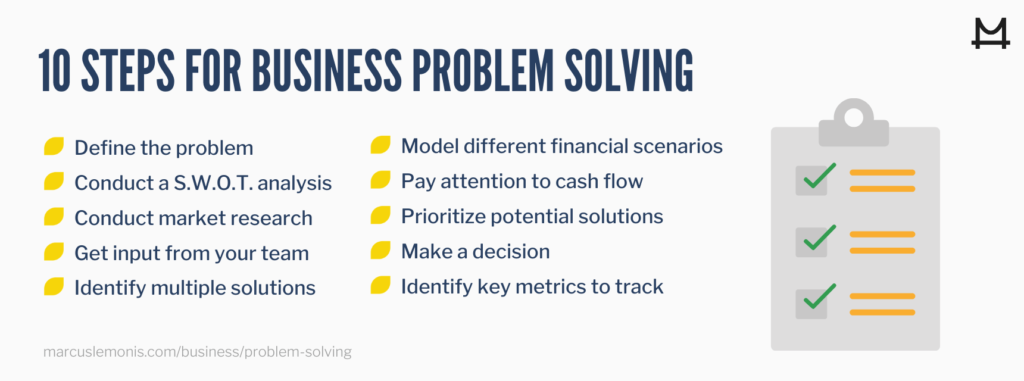
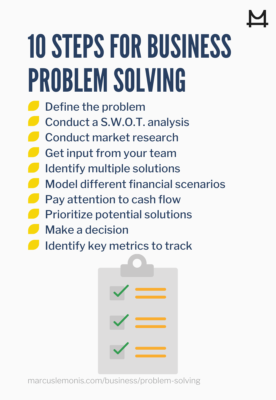
You Don't Have to Solve Business Problems Alone
Life is a team sport and so is business problem solving. Chipotle knew that, and by teaming with the world-famous consulting firm PWC, boosted their stagnating sales. PWC figured out that the underlying issue was that Chipotle wasn’t getting enough repeat business. So, they hoped to form a stronger connection with Chipotle’s existing customers. Together, they tackled the problem on multiple fronts.

They developed a loyalty program with over 50 promotions. They backed the loyalty program with a software solution that kept customers engaged. They even re-trained their entire staff to improve the customer service side of things. The new approach was a huge success, led to 6 million enrollments in the loyalty program, and boosted revenue by 13% in the first year. Hiring a consultant can be a great move, but is only one of the many ways to ask for help. Do your employees have the answers? Could a new hire bring a fresh perspective? Would creating a new role do the trick? No one can do this alone, but the good news is, you don’t have to.
Be Flexible and Willing to Change
There’s a great book called “Mindset” by Dr. Carol Dweck, a professor of psychology at Stanford. Her book explores the “growth mindset,” which means that you’re always looking to learn, grow, and believe those efforts will lead to high achievement. The growth mindset is exactly what you want to bring into business problem solving. Be flexible, willing to change, and open to all solutions. Do a lot of listening, both to your employees, customers, and data. A growth mindset doesn’t care about being right, only about continuous improvement.
Dweck says this growth mindset is a key driver of famous success stories, and if you bring that mindset to business problem solving, you’re well on your way to creating your own success story. So, open your mind and give it a shot. As Marcus would say, “You’ve got this.”
Don't Be Afraid to Reinvent Your Business to Solve a Problem
Make sure you’re open to sweeping changes. Twitter was, and it’s the entire reason they still exist. The social media giant started out as a platform for discovering podcasts called Odeo. But when iTunes started to dominate, Odeo found itself in a pretty tight spot. They knew that any tiny fixes would just be a drop in the bucket. So, Odeo opened their minds to anything and everything. The execs polled their employees in an attempt to reinvent the company. Two weeks later they’d emerged with an idea for a “micro-blogging” platform, which turned into Twitter as we know it today. This is a great, positive example of business problem solving because Odeo leaned into the truth of their situation. They were honest about what they were up against and would stop at nothing to solve it. You can do the same thing as long as you acknowledge that there’s a problem worth solving.
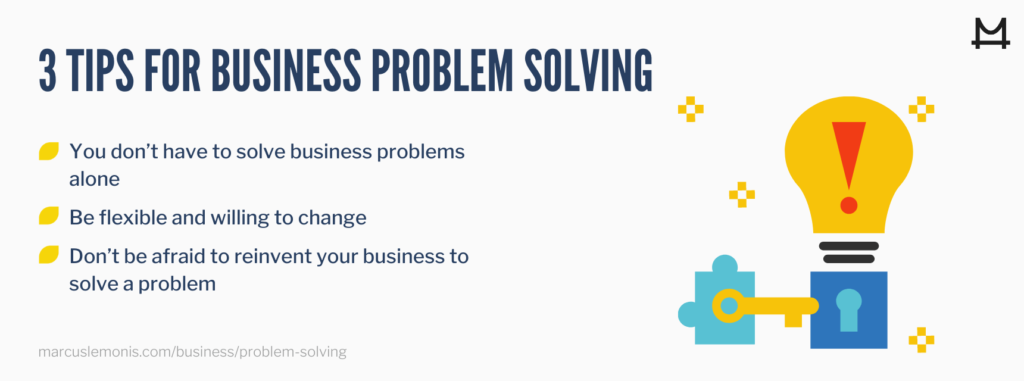
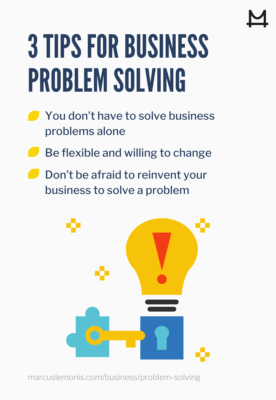
Do you remember that childhood riddle about the wolf, the sheep, and the cabbage? It’s the one where you’re trying to get all three across the river in a single boat without them eating each other. You weren’t coming at it from a place of ego. You weren’t turning a blind eye to the problem. You might’ve even teamed up with a few friends. You were just a little kid, trying to wrap your head around a problem and entertaining all solutions. The best version of business problem solving comes from the same place. As long as you go through the process with an open mind, a little creativity, and a lot of determination, there’s plenty of cabbage waiting for you on the other side.
- What are some things you think about when problem solving?
- What are some suggestions from this article that you can implement in your problem-solving approach?
Coca-ColaCompany.com. (2020, June 18). How Coca-Cola is pivoting its innovation and commercial strategies in the COVID-19 era. Retrieved from
https://www.coca-colacompany.com/news/how-coca-cola-is-pivoting-its-innovation-and-commercial-strategies-in-the-covid-19-eraSurveyMonkey.com.(n.d.). The quick start guide on how to conduct market research. Retrieved from https://www.surveymonkey.com/mp/market-research-surveys/
Stromberg, J. (2014, February 5). Can a statistical model accurately predict olympic medal counts? Retrieved from https://www.smithsonianmag.com/science-nature/can-statistical-model-accurately-predict-olympic-medal-counts-180949627/
BusinessNewsDaily.com. (2019, July 11). What is a decision matrix? Definition and examples. Retrieved from https://www.businessnewsdaily.com/6146-decision-matrix.html
Digital.pwc.com. (n.d.). Redefining fast-casual loyalty, one burrito at a time. Retrieved from https://digital.pwc.com/content/pwc-digital/en/our-work/chipotle-case-study.html





